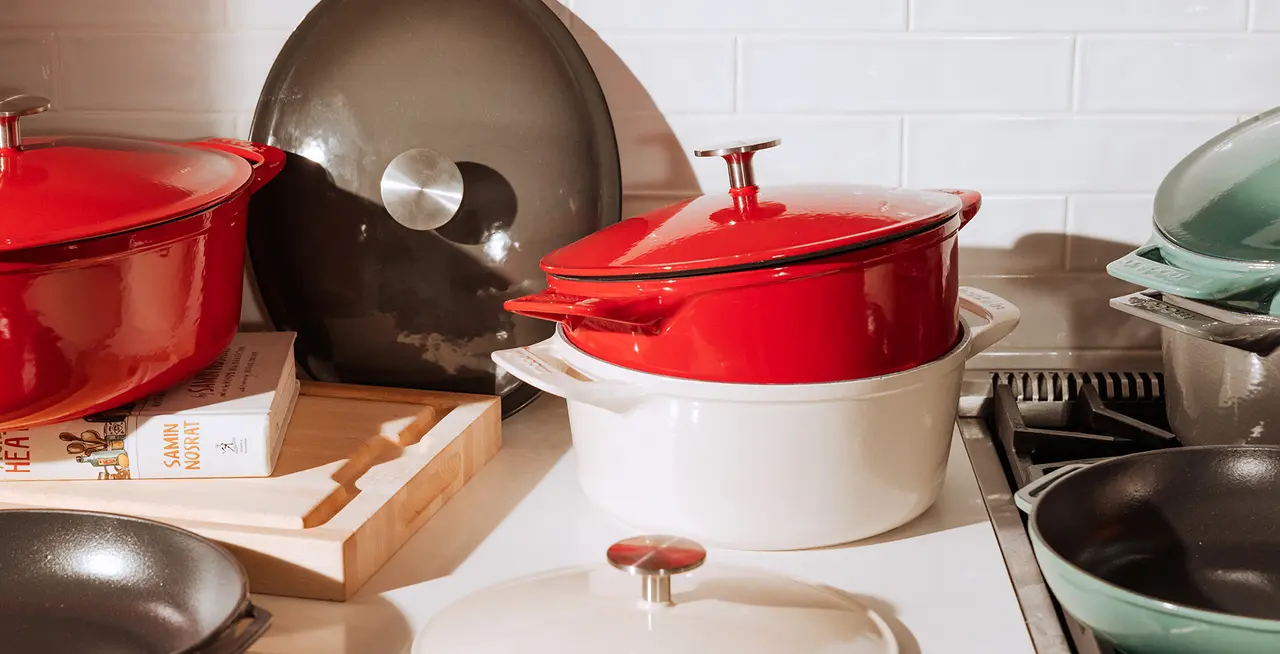If there’s one thing your grandma has in common with a restaurant cook, it’s that they both probably use a cast iron skillet or Dutch oven on a daily basis. These nearly indestructible pieces are some of the most versatile and forgiving types of cookware you can have in your arsenal, and are ideal for cooking everything from crispy latkes to sizzling bibimbap.
Whether you’re new to the cast iron game or looking to switch things up, we’ve put together a comprehensive guide to shopping for cast iron. Learn the differences between enameled and unfinished cast iron, when to use cast iron vs. other types of cookware, and how to use and care for your pot or pan—all to help you pick out the best piece of cast iron for your kitchen needs.
What Is Cast Iron Cookware?
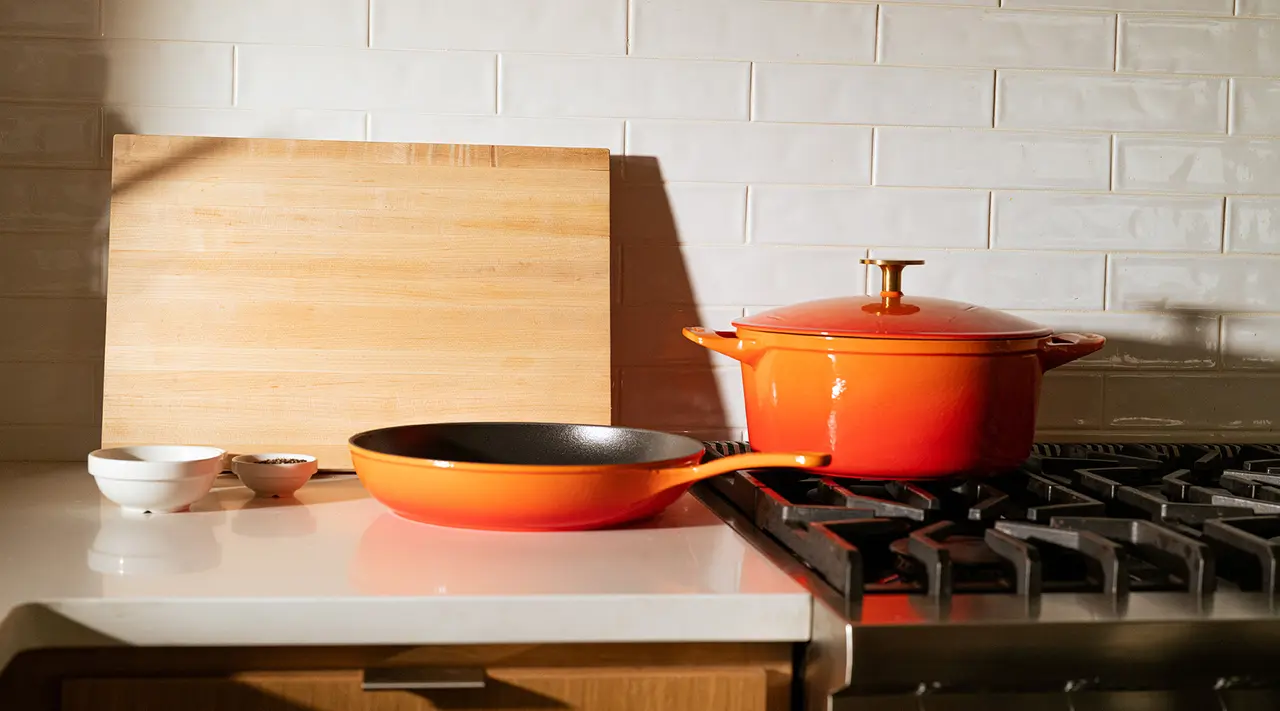
While mass-produced cast iron cookware is a fairly recent phenomenon, the actual process of making cast iron has been around for thousands of years—it’s thought to have originated in ancient China around the 6th century BCE. The process involves pouring an alloy (or compound) of iron and other metals into a mold made of compressed sand.
When the metal is fully cooled, the mold is broken to reveal the finished pan, handle and all, which emerges in a single, solid piece. This method makes for a heavy, durable pan with excellent heat retention, and which—when seasoned correctly—is naturally non stick.
Enameled vs. Unfinished Cast Iron
Compare the glossy, cream-colored interior of your favorite Dutch oven with the nubbly, jet-black appearance of an unfinished cast iron skillet, and you’d be hard pressed to see the similarities. Yet these two pieces of cookware are more alike than you’d think—beneath that delicate enamel is a rugged cast iron core, which gives your Dutch oven the same superior heat retention as an unfinished cast iron skillet.
While these two styles are very similar, they’re not exactly the same. Enameled cast iron has a thin coating of enamel made from powdered glass that’s been fused to the cast iron beneath, which creates a smoother cooking surface that requires less maintenance and is less prone to rusting than unfinished cast iron cookware. Check out our guide for more information on finished vs. unfinished cast iron.
Types of Cast Iron Cookware
One of the (many!) great things about cast iron is that it can be molded into almost any shape, so you can apply the many benefits of cast iron to your tortillas, stir fries, and even baked goods. Outside of skillets and Dutch ovens, you can find cast iron griddles, comals, waffle irons, woks, and even bakeware.
How to Maintain Cast Iron Cookware
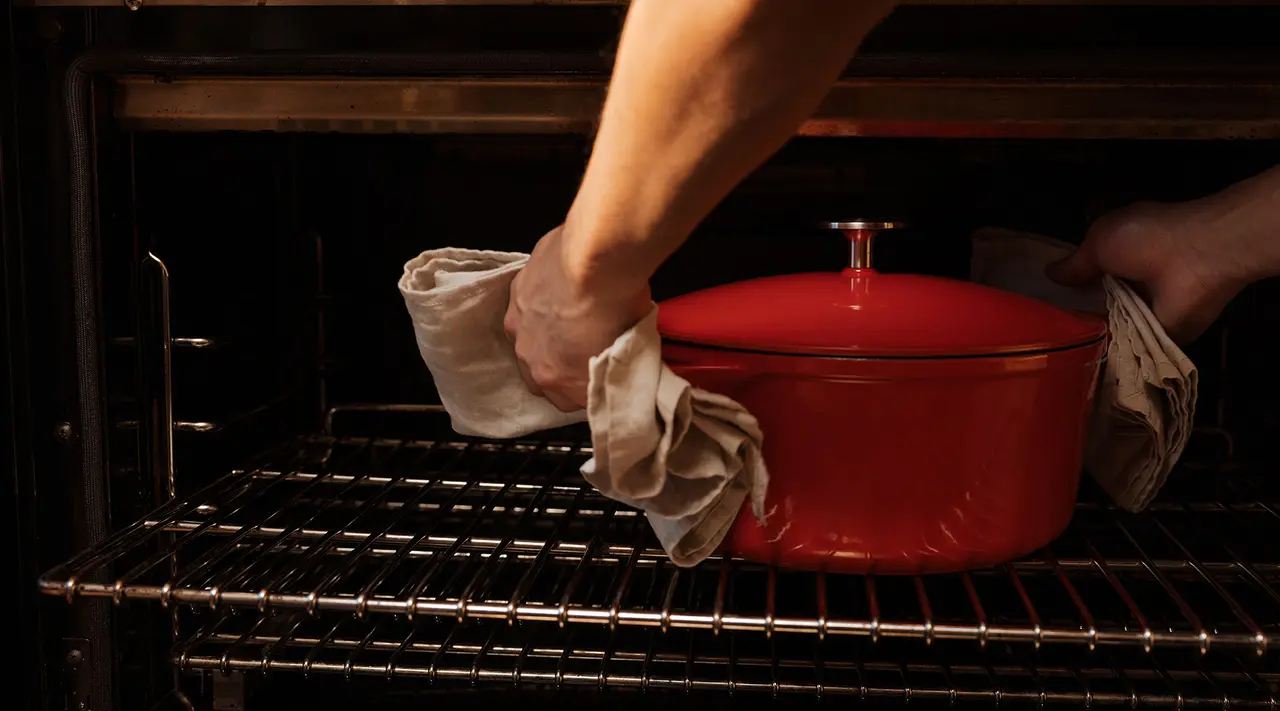
Cast iron cookware is some of the hardiest, most durable you can buy—hence why it’s often passed down through generations. That being said, your cast iron still needs a little TLC on a regular basis. And while that process is slightly more involved with unfinished cast Iron than with enameled cast iron, it’s far from rocket science. Here are some of the key elements of cleaning and caring for cast iron cookware, from seasoning to storing.
Seasoning Cast Iron Cookware
You don’t need to season enameled cast iron, since the glaze makes it non stick to start with. Most unfinished cast iron needs a couple layers of seasoning before cooking with it—basically, baking on layers of unflavored oil to create a naturally non stick surface. Some brands sell pre-seasoned cast iron, which can save you the trouble of the first couple rounds of seasoning—which are often the most annoying and easiest to mess up.
Here’s a step-by-step guide to seasoning your unfinished cast iron cookware.
Step 1: Preheat the Oven
Preheat your oven to 450F, and place a sheet pan lined with aluminum foil on the bottom rack to catch any oil drips.
Step 2: Preheat Your Pan
Before putting your thoroughly clean and completely dry pan in the preheated oven, place it on the burner and turn the heat to medium. Keep the pan on the burner for two minutes, moving it around from time to time so that it heats evenly.
Step 3: Oil Your Pan
Once it’s heated, add a small amount of canola, vegetable, or similar neutral oil to your pot or pan and carefully apply a thin layer all over the inside and outside (including the handle!) with a paper towel. It’s important that the oil you use for seasoning is unflavored, so it doesn’t affect the flavor of your food, and that it has a high smoke point—this means leaving out oils like sesame and olive.
Take it off the heat and give it a wipe down to ensure there’s no excess oil—this can cause a splotchy, uneven seasoning.
Step 4: Place Your Pan in the Oven
Carefully place your heated pan upside down in the oven above the prepared sheet pan, leaving it in for about an hour. We’d recommend opening a window, and/or turning on your fume hood, as your kitchen may get a little smoky during this process.
Step 5: Cool and Repeat
Turn your oven off after the hour is up, leaving your pan in the oven to cool. You can repeat this process a couple more times to really build up the seasoning, but remember that you’ll continue to season your pan as you cook with it. As you get acquainted with your newly seasoned pan, it’s a good idea to begin by cooking fatty things like bacon before diving into delicate proteins like fish and eggs.
Cleaning Cast Iron Cookware
For cleaning both unfinished and enameled cast iron, it’s important to use non-abrasive tools (i.e., no metal or steel wool) and a gentle dish soap—if using dish soap on unfinished cast iron, you may need to reapply the seasoning after washing.
If your enameled cast iron is burnt or discolored, there are a few other methods you can try, such as dedicated cleaners like our Porcelain Cleaner or ingredients like vinegar and baking soda.
Storing Cast Iron Cookware
When storing your cast iron cookware, you can either hang it on pot racks or stack it in a cupboard by placing a dish towel between each layer (if stacking enameled cast iron, you’ll want a thicker material to keep it from scratching or chipping).
It’s also recommended to apply a thin layer of oil to unseasoned cast iron before storing, as this prevents rust from forming. With both enameled and unfinished cast iron, always make sure to thoroughly clean and dry it before storing.
How Does Cast Iron Cookware Compare to Other Cookware?
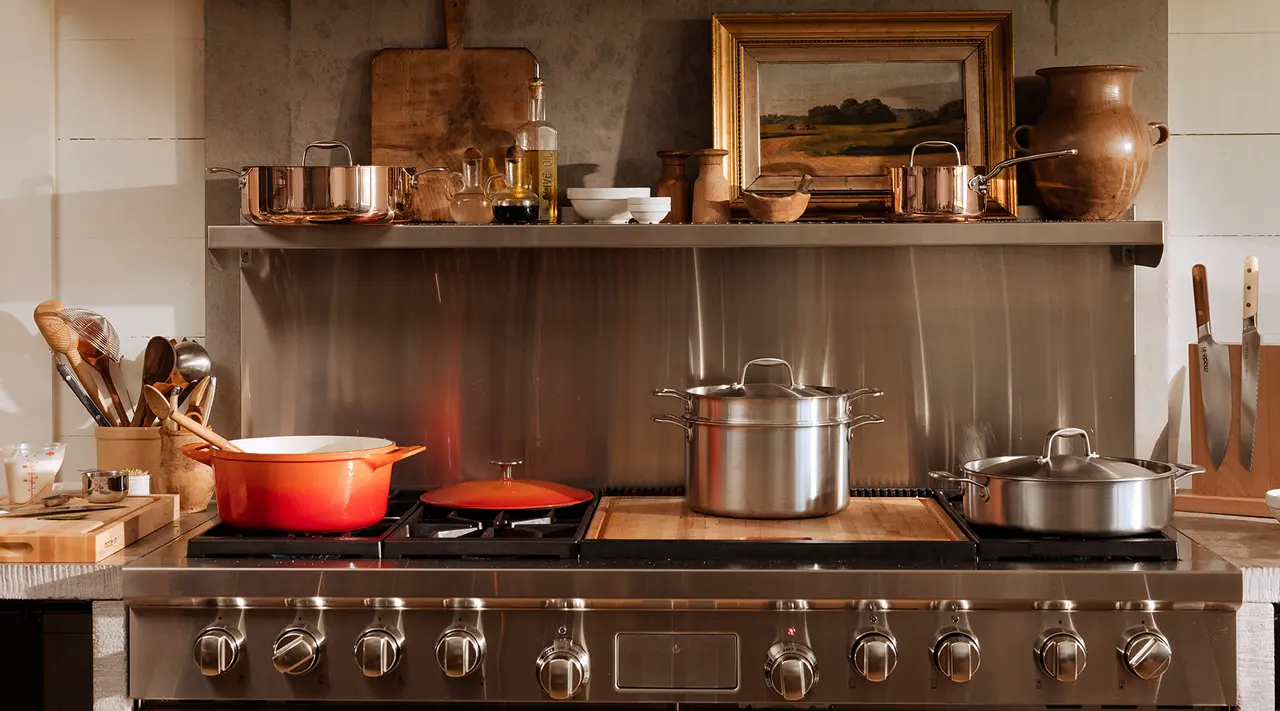
While cast iron can often stand in for other types of cookware, it’s not always the best option. Here’s how cast iron stacks up against carbon steel, stainless steel, and non stick cookware.
Cast Iron vs. Carbon Steel
Cast iron and carbon steel share a number of similarities—they both have excellent heat retention, develop a smooth, non stick surface after seasoning, and are highly durable and long-lasting.
However, there are a couple of key differences between the two. First, carbon steel heats up much more quickly than cast iron, and is also more lightweight, making it easier to pick up and maneuver. It’s also less brittle than cast iron, so it’s less likely to crack if you drop it. You can read more about the differences between these two iconic styles of cookware in our dedicated post to carbon steel vs. cast iron.
Cast Iron vs. Stainless Steel
While it’s true that cast iron has unbeatable heat retention, it pales in comparison to stainless steel when it comes to heat responsiveness. Whereas cast iron takes a long time to both heat up and cool down due to the solid construction and sheer size of the pan, stainless steel cookware (like our Stainless Clad Collection) responds to adjustments in heat incredibly quickly by comparison. This is largely due to the cladded construction, which layers five metals to borrow the heat control, speed, and precision of each.
Stainless steel is also much more lightweight than cast iron, and because it’s non-reactive (unlike unfinished cast iron), you can add acidic ingredients to it without producing any off flavors or stripping seasoning. Thanks to the protective coating, enameled cast iron is also non-reactive.
One area where cast iron has an advantage of stainless steel, however, is the seasoning. Where properly seasoned cast iron offers a smooth, naturally non stick cooking surface, stainless steel is generally more stick prone. Check out our post on stainless steel vs. cast iron to learn more.
Cast Iron vs. Non Stick
Right off the bat, enameled cast iron and non stick have very little in common with one another. Whereas cast iron is heavy and durable and made to withstand roaring temperatures, non stick pans are comparatively delicate—low-quality coatings can warp or scratch easily, most non stick pans can only be heated to a certain temperature before the coating starts to break down, and all have a limited lifespan.
The main thing these two pans have in common is that they both offer a non stick cooking surface. But whether it’s seasoned unfinished cast iron or brand new enameled cast iron, there’s no competing with high-quality coated non stick pans—particularly when it comes to cooking delicate ingredients like fish, shellfish, and eggs. In that area, non stick cookware is the hands-down winner. Check out this post for a more detailed comparison between cast iron and non stick.
How to Cook with Cast Iron

While cooking with cast iron shouldn’t be intimidating, it’ll take a little getting used to if you’ve never done it before. In addition to waiting longer for cast iron to heat up, it also takes longer to cool down, meaning it’s a bit easier to burn or overcook your food if you’re not careful.
On the flip side, this also makes it easier to achieve a deep sear. Because cast iron is also quite a bit heavier than materials like non stick or stainless steel, you won’t be able to pick it up as easily to toss or flip your food.
What are the Advantages of Cooking with Cast Iron Cookware?
It’s hard to overstate our love of cast iron cookware. From its versatility to the fact that it improves—rather than degrades—with time, here are some of its main selling points.
Versatility
Whether you’re lightly sautéing vegetables, baking a rustic cornbread, or flipping crispy-edged pancakes, cast iron’s got your back. It’s been the default cookware tool for pioneers, campers, and outdoorsy folks for a reason—it can withstand (and do) just about anything, whether you’re cooking on the stove, on the grill, in the oven, or over an open flame.
Ages Beautifully
While few pans are designed to last a lifetime, cast iron is one of the few workhorse pans that actually gets better the more you use it—as long as you take good care of it. Think of it like a sourdough starter or mole—or better yet, imagine it aging like a fine wine.
Affordability
While enameled cast iron can get a little pricey, the right piece is justifiably so. Made In’s Enameled Cast Iron Collection features traditional French craftsmanship and hand enameling, resulting in a sustainably produced and long-lasting heirloom piece. If cost is prohibitive, there are additional great-quality unfinished cast iron options on the market—they’ll just cost you quite a bit more in effort and elbow grease.
Tips for Cooking with Cast Iron Cookware
Aside from how to properly clean, season, and store your cast iron cookware, there are a few other cooking-related points to keep in mind.
Be Patient
Unlike stainless steel or carbon steel, it can take a little while for cast iron to heat up. This means you’ll often need to preheat your pan for several minutes before using it to cook. Your wait will be rewarded, however, with perfectly puffed pitas, juicy seared duck breasts, and more.
Avoid Acidic Foods in Unfinished Cast Iron
While your enameled Dutch oven or skillet is absolutely the right tool for simmering tomato sauces and cooking other acidic foods, we’d caution against doing so in unfinished cast iron. This is because cast iron is reactive, meaning that it’ll impart an unpleasant, metallic flavor to your food when it comes into contact with acid. The acid, in turn, will strip the seasoning.
Use It Often
The more often you use your cast iron, the better. Like we mentioned earlier, every time you use your skillet to cook with, you’re adding another microscopic layer of seasoning (that is, as long as you’re adding fat).
Best Recipes for Cast Iron Cookware
Whether you’re looking for pillowy rolls or tender braised meats, chances are cast iron is the right tool for the job. Which type of cast iron you use depends on the recipe. For chilis, sourdough boules, and risotto—i.e. anything that requires high walls and ample volume—we recommend the Enameled Cast Iron Dutch Oven. For dishes like roast chicken or steak, you’re best off with a Skillet, as the low walls allow moisture to evaporate quickly and encourage browning. Read our guide for our favorite uses for Dutch ovens and cast iron skillets.
How to Choose the Right Cast Iron Cookware
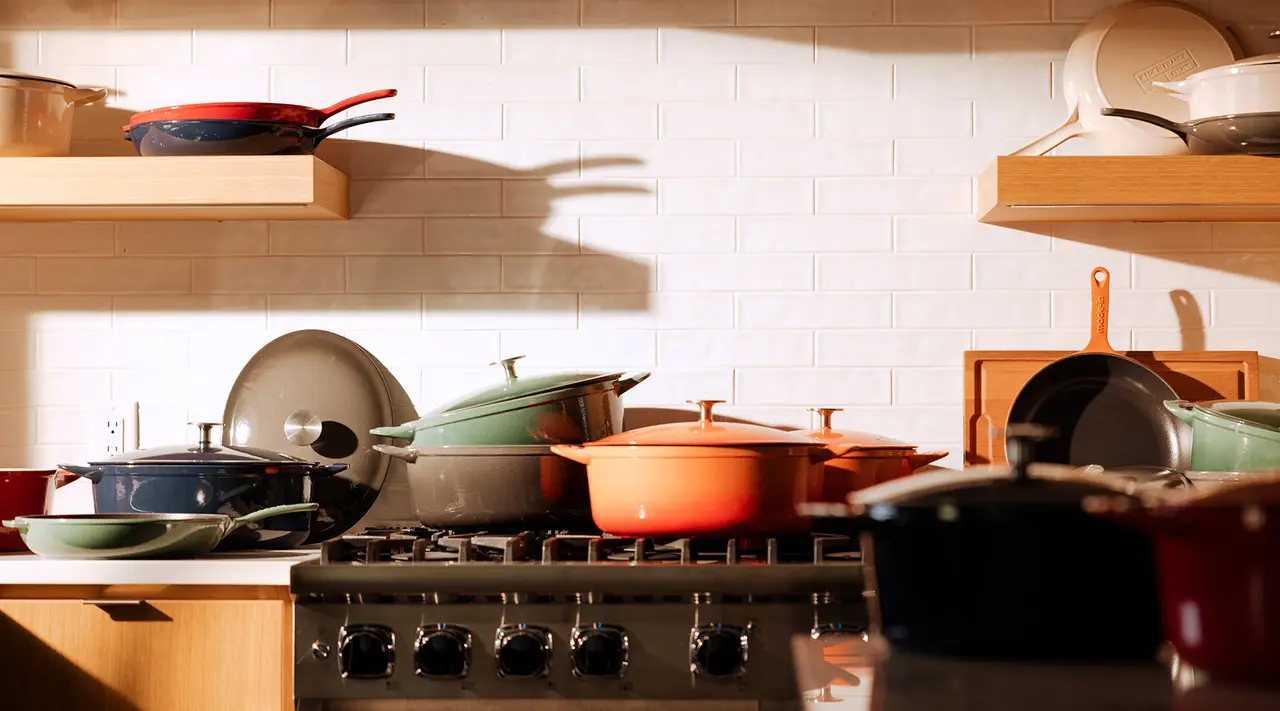
When shopping for cast iron cookware, it’s helpful to think of how you intend to use it. Here are a few categories to evaluate when shopping for cast iron cookware.
Size
Do you have a big family or like to throw a lot of dinner parties? You’ll probably want to buy a 10” or 12” skillet, or a Dutch oven with at least a 5-QT capacity or larger. If you like to make single-serve skillet desserts like crumbles or brownies, or individual pot pies, you’ll want to pick up a few 5” or 6.5” skillets.
Weight
Because cast iron tends to be more brittle than other materials, it needs to be poured thickly to prevent it from cracking.You’ll want a piece of cookware that isn’t so heavy you can’t lift it, but has enough heft that you can be assured it wasn’t cheaply made and will crack easily.
Oven Safety
It’s also good to check whether your pot or pan is fully oven safe. While enameled Dutch ovens can typically withstand high oven temperatures, they sometimes feature handles made of non oven-safe materials. And while you can get high-quality U.S.-made cast iron, in our opinion the best stuff you can buy comes from France—which is where our Enameled Dutch Oven and Cast Iron Skillets are made.
The Best Cast Iron
Long lasting, versatile, and available in a wide array of different styles and shapes, we think cast iron cookware deserves a place in everyone’s kitchen. Plus, if you’re buying unfinished cast iron, it can also be fairly affordable—that’s helpful to know if you’re still on the fence.
If you’re willing to invest in a piece of heirloom cast iron, however, we’d recommend starting with Made In’s Enameled Cast Iron Collection that includes both Dutch Ovens and Skillets. These pieces are made and hand-finished by expert craftsmen at a foundry in Northeast France, which has been in operation since the 1920s. Oven Safe up to 580F, as well as induction-compatible, they’re the perfect blend of style and performance.
